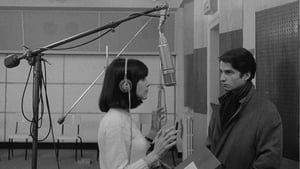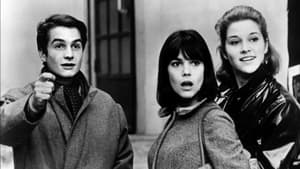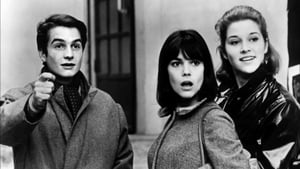Contact: info@alwanfilm.com
Video Sources 0 Views
- Watch trailer
- Masculin Féminin


Synopsis
Table of Contents
ToggleReview: Masculin Féminin 1966 Colorized – A Revolutionary Exploration of Youth and Society

Introduction
In the dynamic and transformative landscape of 1960s cinema, few films capture the zeitgeist as poignantly as Jean-Luc Godard’s Masculin Féminin 1966. This avant-garde masterpiece delves into the lives and loves of young Parisians, encapsulating the spirit of the era with its innovative narrative style and socio-political commentary. This article will explore the intricate details of “Masculin Féminin 1966,” examining its cast, story, and the critical reception it received. Additionally, we will discuss the film’s impact on cinema and its enduring legacy.
Check The Full Colorized Movies List
Check Our Colorized Movies Trailer Channel
Understanding Masculin Féminin 1966 Colorized: Director, Cast, and Genre
Masculin Féminin 1966 is the brainchild of Jean-Luc Godard, a pivotal figure in the French New Wave movement. Godard’s unique directorial vision is evident throughout the film, which blends documentary-style realism with fictional narrative elements. This hybrid approach allows Godard to explore the complexities of youth culture and societal change in a way that is both engaging and thought-provoking.
The film stars Jean-Pierre Léaud as Paul, a young man navigating the turbulent waters of love, politics, and identity. Opposite him, Chantal Goya plays Madeleine, a burgeoning pop singer whose ambitions and desires reflect the changing role of women in society. The supporting cast includes Marlene Jobert as Elisabeth and Catherine-Isabelle Duport as Catherine, both of whom add depth and nuance to the film’s exploration of gender dynamics and personal relationships.
Masculin Féminin 1966 defies traditional genre classifications, blending elements of drama, romance, and social commentary. It is a film that exists at the intersection of personal and political, capturing the essence of a generation caught between tradition and modernity.
Exploring the World of Masculin Féminin 1966 Colorized: Plot and Characters
Masculin Féminin 1966 offers a mosaic of interconnected stories centered around Paul, a disenchanted young man who has recently completed his military service. As he navigates the bustling streets of Paris, Paul becomes entangled in a web of relationships and ideological conflicts that reflect the broader societal upheavals of the 1960s.
The film’s plot is structured around 15 vignettes, each delving into different aspects of Paul’s life and the lives of those around him. From philosophical debates in cafés to intimate moments of romance and confrontation, these scenes paint a vivid portrait of a generation grappling with profound changes in culture and values.
Paul’s relationship with Madeleine serves as the emotional core of the film, highlighting the tensions between personal desires and societal expectations. Madeleine’s aspirations as a pop singer and Paul’s political activism create a dynamic interplay between the personal and the political, underscoring the complexities of gender and identity in a rapidly evolving world.
The Art of Film Colorization
While Masculin Féminin 1966 was originally shot in black and white, the topic of film colorization remains relevant in discussions of cinematic preservation and reinterpretation. Film colorization involves adding color to black and white footage, a process that can alter the visual and emotional impact of a film.
The art of colorization is both a technical and creative endeavor, requiring a delicate balance between fidelity to the original and the introduction of new visual dimensions. While colorization can make classic films more accessible to contemporary audiences, it also raises questions about the preservation of artistic intent and historical authenticity.
Early Colored Films: A Brief History
The history of early colored films is marked by innovation and experimentation, with filmmakers continually seeking new ways to enhance the visual appeal of their work. From the hand-painted frames of early cinema to the development of Technicolor, the quest for color has been a driving force in the evolution of filmmaking.
Early colored films offered audiences a new way to experience stories, adding depth and vibrancy to the cinematic palette. However, the transition from black and white to color was not without its challenges, including technical limitations and concerns about the impact on narrative and aesthetic integrity.
Masculin Féminin 1966 and Its Early Colored Version
Although “Masculin Féminin 1966” has not been officially colorized, the idea of a colorized version sparks intriguing questions about how such a reinterpretation might affect the viewing experience. Godard’s use of black and white cinematography is integral to the film’s aesthetic, emphasizing contrasts and creating a stark, documentary-like quality that underscores its social realism.
A colorized version of Masculin Féminin 1966 could potentially highlight different aspects of the film’s visual and emotional landscape. For instance, the vibrant streets of Paris and the characters’ distinct styles could be brought to life in new ways, offering a fresh perspective on Godard’s exploration of youth and society.
The Debate Over Film Colorization
The debate over film colorization is a contentious one, with strong arguments on both sides. Proponents argue that colorization can breathe new life into classic films, making them more appealing and accessible to modern audiences. They also point to advancements in technology that allow for more accurate and nuanced colorization processes.
Critics, however, contend that colorization can undermine the artistic integrity of the original work, altering the filmmaker’s intended vision and diminishing the historical context. They argue that black and white cinematography is a deliberate artistic choice that should be preserved and respected.
Ultimately, the debate over film colorization reflects broader questions about the preservation of cultural heritage and the role of innovation in the arts. As technology continues to evolve, these discussions will remain central to the future of cinematic preservation and reinterpretation.
Examining Masculin Féminin 1966 as an Early Colored Film
Imagining “Masculin Féminin 1966” as an early colored film offers a fascinating exercise in cinematic what-ifs. Colorization could enhance certain elements of the film, such as the vibrancy of Parisian life and the distinct personalities of the characters. However, it might also detract from the stark, realistic quality that black and white cinematography provides.
Godard’s use of black and white serves to strip the film of unnecessary distractions, focusing the viewer’s attention on the characters and their interactions. It also creates a sense of timelessness, connecting the personal struggles of the characters to broader historical and social contexts. A colorized version might risk losing some of this immediacy and focus, potentially altering the film’s impact and message.
Influence and Legacy: Masculin Féminin 1966 Colorized’s Impact on Cinema
“Masculin Féminin 1966” has left an indelible mark on the cinematic landscape, influencing generations of filmmakers and artists. Its innovative narrative structure, socio-political commentary, and bold exploration of youth culture have inspired countless films and directors, both within and beyond the French New Wave.
Godard’s approach to storytelling, characterized by a blend of realism and abstraction, has become a touchstone for filmmakers seeking to push the boundaries of cinematic expression. The film’s exploration of gender dynamics and societal change continues to resonate with contemporary audiences, highlighting the enduring relevance of its themes and insights.
Director’s Cinematic Legacy: Beyond Masculin Féminin 1966 Colorized
Jean-Luc Godard’s cinematic legacy extends far beyond Masculin Féminin 1966, encompassing a prolific and diverse body of work that has redefined the art of filmmaking. From the groundbreaking “Breathless” to the experimental “Week-end,” Godard’s films challenge conventional narrative structures and explore complex themes of identity, politics, and culture.
Godard’s influence can be seen in the work of numerous directors, from Martin Scorsese and Quentin Tarantino to Wong Kar-wai and Lars von Trier. His willingness to experiment with form and content has inspired generations of filmmakers to push the boundaries of cinematic storytelling and explore new ways of engaging with audiences.
Themes Explored in Masculin Féminin 1966 Colorized
At its core, Masculin Féminin 1966 is a meditation on the complexities of youth, gender, and society. The film explores themes of love, identity, and political engagement, capturing the spirit of a generation caught between tradition and modernity.
The relationship between Paul and Madeleine serves as a focal point for the film’s exploration of gender dynamics and societal expectations. Their interactions highlight the tensions between personal desires and social roles, reflecting the broader struggles of a society in flux.
Godard’s use of dialogue and visual imagery creates a rich tapestry of ideas and emotions, inviting viewers to contemplate the challenges and contradictions of contemporary life. The film’s innovative narrative structure, characterized by its episodic format and intertextual references, underscores the complexity of its themes and the depth of its insights.
Reception and Controversy Surrounding Masculin Féminin 1966 Colorized
Upon its release, “Masculin Féminin 1966” garnered both acclaim and controversy, reflecting the provocative nature of Godard’s work. Critics praised the film for its bold exploration of youth culture and its innovative narrative techniques, while others criticized its fragmented structure and perceived lack of coherence.
The film’s candid depiction of sexuality and its critical stance on consumer culture sparked debate among audiences and critics alike. Some viewed it as a revolutionary critique of contemporary society, while others saw it as a self-indulgent exercise in stylistic experimentation.
Despite the controversy, “Masculin Féminin 1966” has come to be regarded as one of Godard’s most important and influential works, a film that captures the essence of its time while offering timeless insights into the human condition.
Where to Watch Masculin Féminin 1966 Colorized Online
For those eager to experience the brilliance of “Masculin Féminin 1966,” the film is available on various streaming platforms, ensuring accessibility to audiences worldwide. Platforms such as Criterion Channel, Amazon Prime Video, and HBO Max often feature the film as part of their classic cinema collections, providing opportunities for both new viewers and long-time fans to engage with this cinematic masterpiece.
FAQs About Masculin Féminin 1966 Colorized
Common queries surrounding “Masculin Féminin 1966” range from its narrative style to its thematic depth. By addressing these frequently asked questions, viewers can gain a deeper understanding of the film’s enduring appeal and cultural significance.
Q: What is the narrative style of Masculin Féminin 1966 ?
A: “Masculin Féminin 1966” employs an episodic narrative structure, composed of 15 vignettes that explore different aspects of the characters’ lives. This fragmented approach reflects the disjointed, chaotic nature of the 1960s youth experience, blending realism with abstract, experimental elements.
Q: How does Masculin Féminin 1966 reflect the sociopolitical context of the 1960s?
A: The film captures the spirit of the 1960s through its exploration of youth culture, political activism, and gender dynamics. Through its characters and their interactions, “Masculin Féminin 1966” addresses issues such as consumerism, sexual liberation, and the quest for identity in a rapidly changing world.
Q: What are some of the key themes in Masculin Féminin 1966?
A: Key themes include the complexities of gender relations, the impact of political and social change on personal identity, and the tension between individual desires and societal expectations. The film also delves into the role of media and pop culture in shaping the aspirations and behaviors of young people.
Q: How does Jean-Luc Godard’s directing style influence the film?
A: Godard’s directing style, characterized by its innovative use of jump cuts, direct address, and intertextual references, creates a dynamic and engaging viewing experience. His approach challenges conventional narrative techniques and invites viewers to actively engage with the film’s themes and ideas.
Conclusion
Masculin Féminin 1966 stands as a landmark achievement in cinema, capturing the essence of a generation caught in the throes of social and political upheaval. Jean-Luc Godard’s innovative narrative techniques and bold thematic exploration offer a profound and timeless commentary on the human condition. Whether viewed in its original black and white format or imagined through the lens of colorization, the film’s impact and relevance remain undiminished.
As we continue to grapple with the complexities of modern life, “Masculin Féminin 1966” serves as a powerful reminder of the enduring power of cinema to reflect, critique, and inspire. Its exploration of youth, identity, and society resonates as strongly today as it did upon its release, underscoring the timeless nature of Godard’s vision.
For those seeking to experience the full depth and richness of “Masculin Féminin 1966,” viewing it in its original form is essential. The stark beauty of its black and white cinematography, combined with its innovative narrative structure, offers a unique and immersive viewing experience that captures the spirit of a revolutionary era.
As we look to the future of cinema, the lessons of “Masculin Féminin 1966” remind us of the importance of preserving artistic integrity while embracing innovation and change. In honoring the legacy of Jean-Luc Godard and his seminal work, we celebrate the transformative power of film and its ability to illuminate the complexities of the human experience.
















